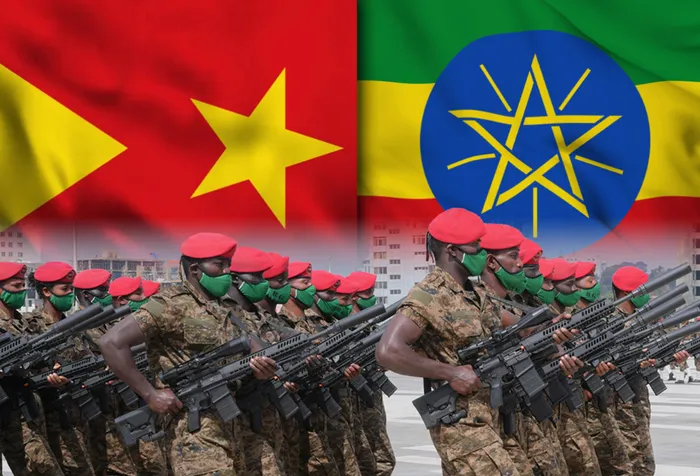Ethiopia’s Amhara region in turmoil

Graphic: Timothy Alexander/ African News Agency (ANA)
Picture: Picture: Amanuel Sileshi/AFP – People gather in Addis Ababa, Ethiopia, on October 22, 2022 during a demonstration in support of Ethiopia armed forces.
By Sara Tadesse Gebremariam
The situation on the ground remained tense following the GoE’s announcement to disband regional Special Forces. The government maintains that change is essential for national unity, however, this plan has faced opposition from Fano, non-state militia with no formal command structure, taking part in a week of violent protests across the region in April 2023.
Tensions between the former allies turned into fierce fighting when the GoE ordered the Ethiopian National Defence Force (ENDF) to act against “extremists” following the murder of the head of the Amhara Prosperity Party by an unidentified armed group in early August. The Fano and Amhara ethnic militias, who had been allies in the two-year war against the Tigray region, insisted on the withdrawal of ENDF troops from the area, and they also took control of what were termed ‘contested areas’.

The country found itself in such a predicament once again as it failed to address the root causes of conflict across northern Ethiopia. Among others, there are still two main concerns: firstly, the federal government enticed Amhara forces to join forces in seizing Western and Southern Tigray, which many Amhara refer to as Welkayit and Raya, in asserting historical claims to the territories.
The troops then forcibly displaced ethnic Tigrayans from their lands, an act labelled as “ethnic cleansing” by the US Secretary of State Antony Blinken. Secondly, the overall security situation in Amhara deteriorated during and after the northern conflict with ENDF failing to defend the region from TPLF’s advance in 2021 and 2022. Furthermore, the government failed to protect an influx of ethnic Amhara fleeing intermittent violence in Oromia and Benshangul-Gumuz, compelling the militia to take matters into their own hands.
In light of this prevailing distrust, the recent initiative to integrate security forces from Ethiopia’s 11 regions was seen as an attempt to diminish the Amhara’s capacity to protect itself against aggression from other regions. The GoE has been accused of continued engagement with the TPLF and the Oromo Liberation Army (OLA) in a way that will counteract accountability for the atrocities committed against the Amhara.
While the government denies such claims, it acknowledges that many of the special forces were integrated with the Fano insurgency, bolstering their fighting capabilities. In an escalation of a simmering feud between the two former allies, the Fano have briefly captured two towns – Gondar and Bahir Dar – and the industrial city of Debrebirhan. Several reports of airstrikes in the region led to numerous civilian deaths and mass killings in Finote Selam, Bahir Dar and Shewa Robit. Consequently, Ethiopia’s federal cabinet declared a six-month state of emergency and established a military command post in the Amhara region that reports directly to the Prime Minister following clashes across the Amhara region which has developed into a security crisis.
The Pretoria peace talks brought representatives of the federal government and those of the Tigray leadership to the negotiation table but failed to include concessions to a silent main party – the Amhara region – and that the solution to the problem will require resolving the issues of the contested areas, including the major concern of the Disarmament, Demobilisation and Reintegration (DDR) process.
The exclusion of such issues in the negotiation process was met with deep suspicion among the Amhara who criticised the talks for not being all-encompassing, adding yet another layer of complexity to years of ethnic tension. Political deadlocks on the status of Welkayit and Raya, albeit being part of Tigray in constitutional terms, contain many ethnic Amhara communities which the regional administration consider theirs as a fait accompli. The Fano militia is willing to back such claim with force by rejectingany attempts from the federal government to challenge the status quo.
The Pretoria Agreement calls for the return to pre-conflict arrangements while denoting a referendum as a prospective approach to settle the territorial dispute. The government supports that process, while opponents argue that as the local population was not consulted when the Ethiopian People’s Revolutionary Democratic Front (EPRDF) government, led by the TPLF designated these areas as part of the Tigray state in the 1990s, the current government should reverse the decision.
Nonetheless, it is a perilous stalemate, as the Abiy administration will need to balance trading off current instability in Amhara with risking a return to civil war in Tigray if the Pretoria Agreement is not implemented as agreed. Persistent insecurity in the north – whether in Amhara or Tigray or both – risks undermining the peace agreement by bolstering hardliners, and increasing mistrust, which makes a return to war more likely. Resolving these tensions will require a national dialogue where political and ethnic groups can discuss how best to resolve their differences in ways that can ensure the overall peace and stability of the country, which is in everyone’s interest.
*Sara Tadesse Gebremariam is a research fellow in the Research Unit at ACCORD and a Peace, Security and Development Associate Fellow with the African Leadership Centre at King’s College London.
This article was first published in ACCORD.